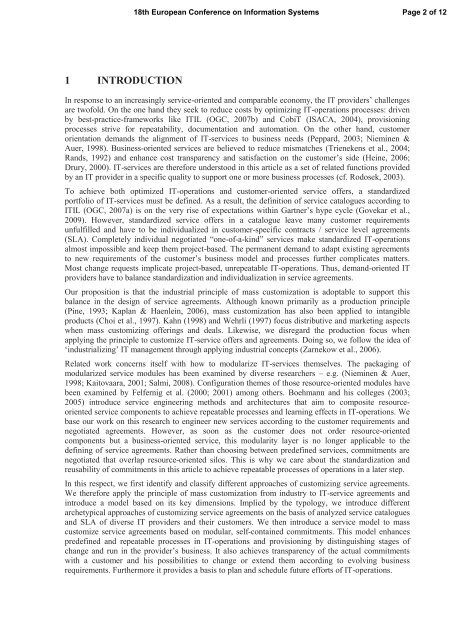Kundenorientierte Gestaltung und Vereinbarung standardisierter IT ...
Kundenorientierte Gestaltung und Vereinbarung standardisierter IT ...
Kundenorientierte Gestaltung und Vereinbarung standardisierter IT ...
Sie wollen auch ein ePaper? Erhöhen Sie die Reichweite Ihrer Titel.
YUMPU macht aus Druck-PDFs automatisch weboptimierte ePaper, die Google liebt.
1 INTRODUCTION<br />
18th European Conference on Information Systems<br />
In response to an increasingly service-oriented and comparable economy, the <strong>IT</strong> providers’ challenges<br />
are twofold. On the one hand they seek to reduce costs by optimizing <strong>IT</strong>-operations processes: driven<br />
by best-practice-frameworks like <strong>IT</strong>IL (OGC, 2007b) and CobiT (ISACA, 2004), provisioning<br />
processes strive for repeatability, documentation and automation. On the other hand, customer<br />
orientation demands the alignment of <strong>IT</strong>-services to business needs (Peppard, 2003; Nieminen &<br />
Auer, 1998). Business-oriented services are believed to reduce mismatches (Trienekens et al., 2004;<br />
Rands, 1992) and enhance cost transparency and satisfaction on the customer’s side (Heine, 2006;<br />
Drury, 2000). <strong>IT</strong>-services are therefore <strong>und</strong>erstood in this article as a set of related functions provided<br />
by an <strong>IT</strong> provider in a specific quality to support one or more business processes (cf. Rodosek, 2003).<br />
To achieve both optimized <strong>IT</strong>-operations and customer-oriented service offers, a standardized<br />
portfolio of <strong>IT</strong>-services must be defined. As a result, the definition of service catalogues according to<br />
<strong>IT</strong>IL (OGC, 2007a) is on the very rise of expectations within Gartner’s hype cycle (Govekar et al.,<br />
2009). However, standardized service offers in a catalogue leave many customer requirements<br />
unfulfilled and have to be individualized in customer-specific contracts / service level agreements<br />
(SLA). Completely individual negotiated “one-of-a-kind” services make standardized <strong>IT</strong>-operations<br />
almost impossible and keep them project-based. The permanent demand to adapt existing agreements<br />
to new requirements of the customer’s business model and processes further complicates matters.<br />
Most change requests implicate project-based, unrepeatable <strong>IT</strong>-operations. Thus, demand-oriented <strong>IT</strong><br />
providers have to balance standardization and individualization in service agreements.<br />
Our proposition is that the industrial principle of mass customization is adoptable to support this<br />
balance in the design of service agreements. Although known primarily as a production principle<br />
(Pine, 1993; Kaplan & Haenlein, 2006), mass customization has also been applied to intangible<br />
products (Choi et al., 1997). Kahn (1998) and Wehrli (1997) focus distributive and marketing aspects<br />
when mass customizing offerings and deals. Likewise, we disregard the production focus when<br />
applying the principle to customize <strong>IT</strong>-service offers and agreements. Doing so, we follow the idea of<br />
‘industrializing’ <strong>IT</strong> management through applying industrial concepts (Zarnekow et al., 2006).<br />
Related work concerns itself with how to modularize <strong>IT</strong>-services themselves. The packaging of<br />
modularized service modules has been examined by diverse researchers – e.g. (Nieminen & Auer,<br />
1998; Kaitovaara, 2001; Salmi, 2008). Configuration themes of those resource-oriented modules have<br />
been examined by Felfernig et al. (2000; 2001) among others. Boehmann and his colleges (2003;<br />
2005) introduce service engineering methods and architectures that aim to composite resourceoriented<br />
service components to achieve repeatable processes and learning effects in <strong>IT</strong>-operations. We<br />
base our work on this research to engineer new services according to the customer requirements and<br />
negotiated agreements. However, as soon as the customer does not order resource-oriented<br />
components but a business-oriented service, this modularity layer is no longer applicable to the<br />
defining of service agreements. Rather than choosing between predefined services, commitments are<br />
negotiated that overlap resource-oriented silos. This is why we care about the standardization and<br />
reusability of commitments in this article to achieve repeatable processes of operations in a later step.<br />
In this respect, we first identify and classify different approaches of customizing service agreements.<br />
We therefore apply the principle of mass customization from industry to <strong>IT</strong>-service agreements and<br />
introduce a model based on its key dimensions. Implied by the typology, we introduce different<br />
archetypical approaches of customizing service agreements on the basis of analyzed service catalogues<br />
and SLA of diverse <strong>IT</strong> providers and their customers. We then introduce a service model to mass<br />
customize service agreements based on modular, self-contained commitments. This model enhances<br />
predefined and repeatable processes in <strong>IT</strong>-operations and provisioning by distinguishing stages of<br />
change and run in the provider’s business. It also achieves transparency of the actual commitments<br />
with a customer and his possibilities to change or extend them according to evolving business<br />
requirements. Furthermore it provides a basis to plan and schedule future efforts of <strong>IT</strong>-operations.<br />
Page 2 of 12

















